Tom's Guide Verdict
The 3DR Solo offers a lot of features in an easy-to-fly package that pushes drone smarts to the limit.
Pros
- +
Attractive design
- +
Easy to fly
- +
Fast and maneuverable
- +
Shoots steady, sharp video.
Cons
- -
Requires additional GoPro camera
Why you can trust Tom's Guide
The Solo is the latest drone from 3D Robotics, which makes its software available for download, ready for hacking or rewriting. But even if you're not a tinkerer, you're likely to enjoy flying the Solo. It is a simple to control, but powerful. The company packs in a lot of features for its airborne movie maker, but you'll need to purchase a few add-ons to take full advantage.
Editor's Note (1/26/17): 3D Robotics is no longer selling a consumer version of the 3DR Solo, but will continue to support the consumer model for the foreseeable future, and is still providing a one-year hardware warranty.
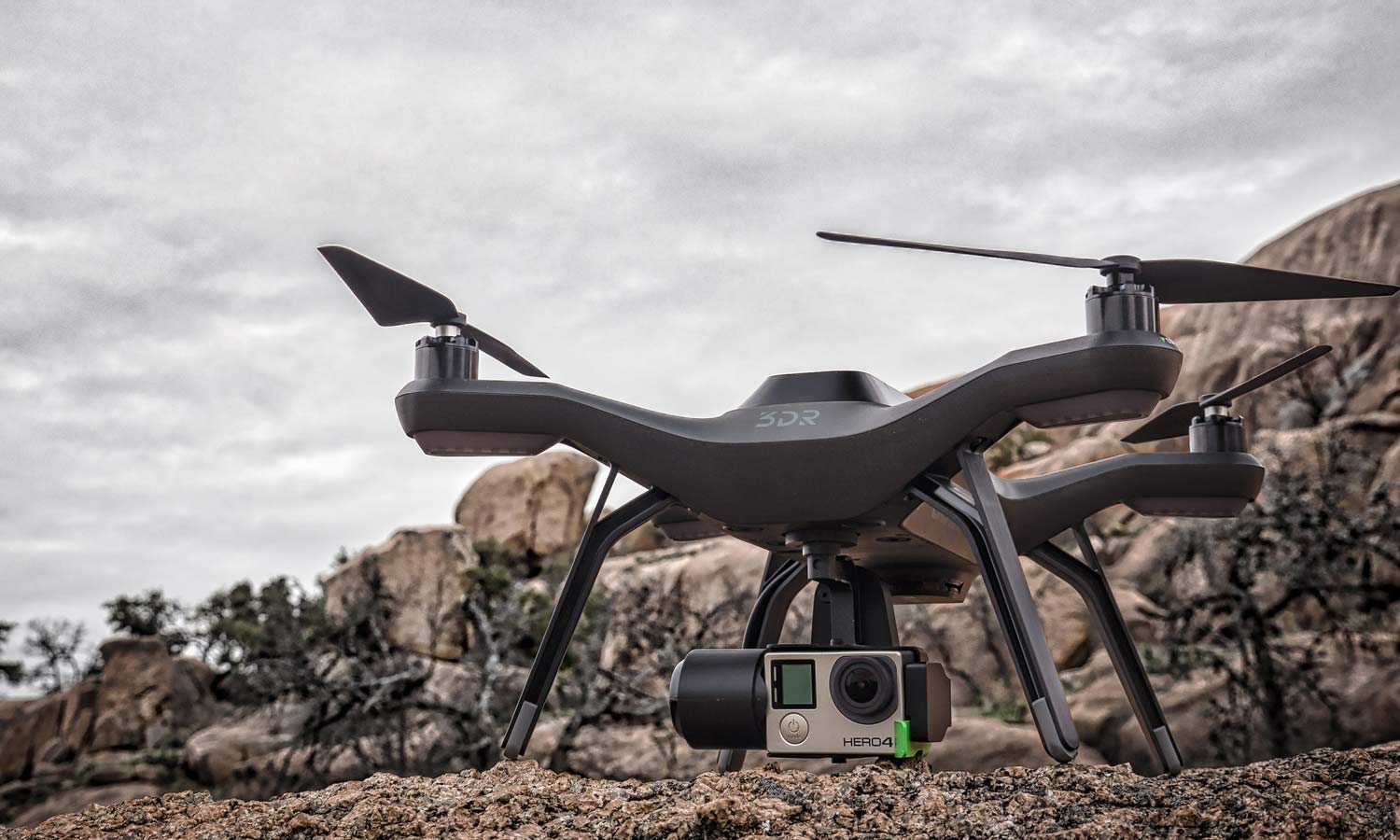
A complete kit includes the Solo drone, the gimbal accessory and a GoPro action camera. That makes it more involved than the DJI Phantom 3 Standard, which offers comparable specs without requiring any addons. However, the Solo's software is more developed and is easier to use, and there is more opportunity for expansion, through both software and hardware. That might tip the balance for pros, and those who want to experiment with truly autonomous drones.
Design
Minimal is the word that springs to mind when you see the Solo. It’s an angular lump of matte black plastic that would look perfect hovering over the lifeless body of John Connor on the set of a Terminator movie. A large 5,200mAh battery attaches on top of that sleek body, right next to the power button.
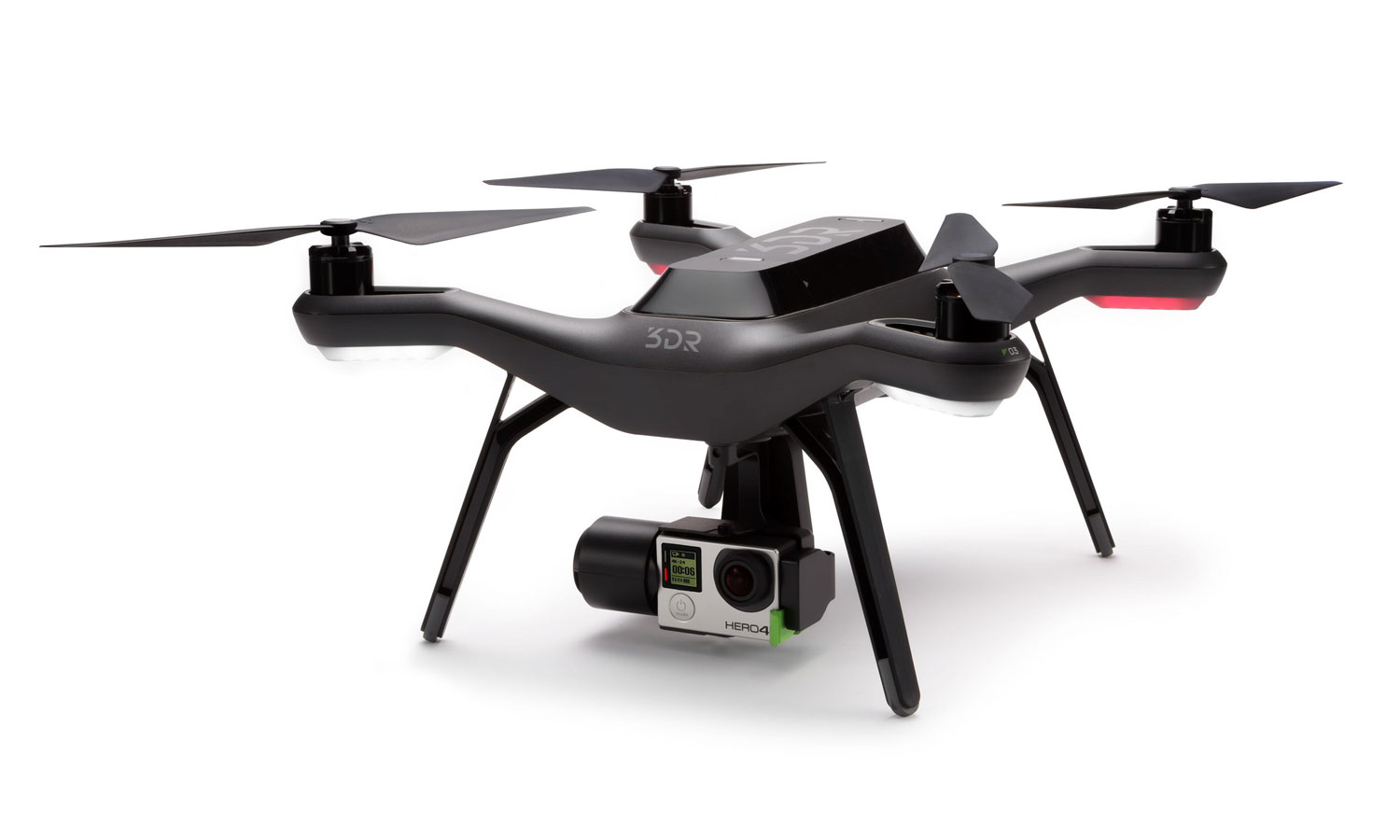
The quadcopter is fairly large at just under 19 inches from tip to tip, and heavy: with the battery, gimbal and camera installed, it weighs in at a hefty 3.35 pounds. That means it needs to be registered with the FAA, as it is over the 0.5 pounds minimum weight.
Once you turn the Solo on, the quadcopter gets a bit more colorful, as bright multicolor LEDs under each motor display the status. These are easily visible in daylight, and are rather bright at night. In flying mode, red indicates the front of the quadcopter and blue the back.
On the underside sits an accessory connector as well as a number of much smaller LEDs showing the status of the device while it is starting up. These lights blink while the drone is starting and connecting, and the speed of these blinks can be used to diagnose a problem if something fails. At present, while no available devices use the connector port, 3DR is hoping developers will make such accessories through the company's Made for Solo program.
At the front of the base is the camera holder, which fits a GoPro Hero. In the standard model, this is a simple frame that holds the camera in place, but 3DR also offers an active gimbal that can pan, tilt and rotate the camera. A cable connects to the gimbal from the guts of the drone, which allows you to control both the camera and the gimbal itself. For either the standard or the gimbal mount, an HDMI cable plugs into the camera, feeding a live preview back to the smartphone app that controls the drone. We tested both the standard camera holder and the $380 3-axis gimbal, while using a GoPro 3+ Silver.
Specs
Rotors: 4 (2 blades per rotor) replaceable, 10-inch diameter
Battery Size: 14.7V 5200-mAh Li-ion, removable
Battery Life: 20/22 minutes (claimed/tested)
Camera: GoPro Hero 3+/4, up to 4K/60P resolution
Smartphone Controlled: Yes
FAA Registration: Yes
Size: 18.5 x 1.8 x 0.7 feet (rotor tip to rotor tip, height inc. rotors)
Weight: 3.35 lbs.
Controller
The controller that comes with the Solo is a similarly styled hunk of black matte plastic, with a glossy plastic top. It is replete with eight buttons and dials, as well as the two control sticks and a small OLED display in the middle. This display doesn't show the live video from the drone. Instead, it shows the status of the drone, indicating things like the battery life, the number of GPS satellites it can see and flight mode.
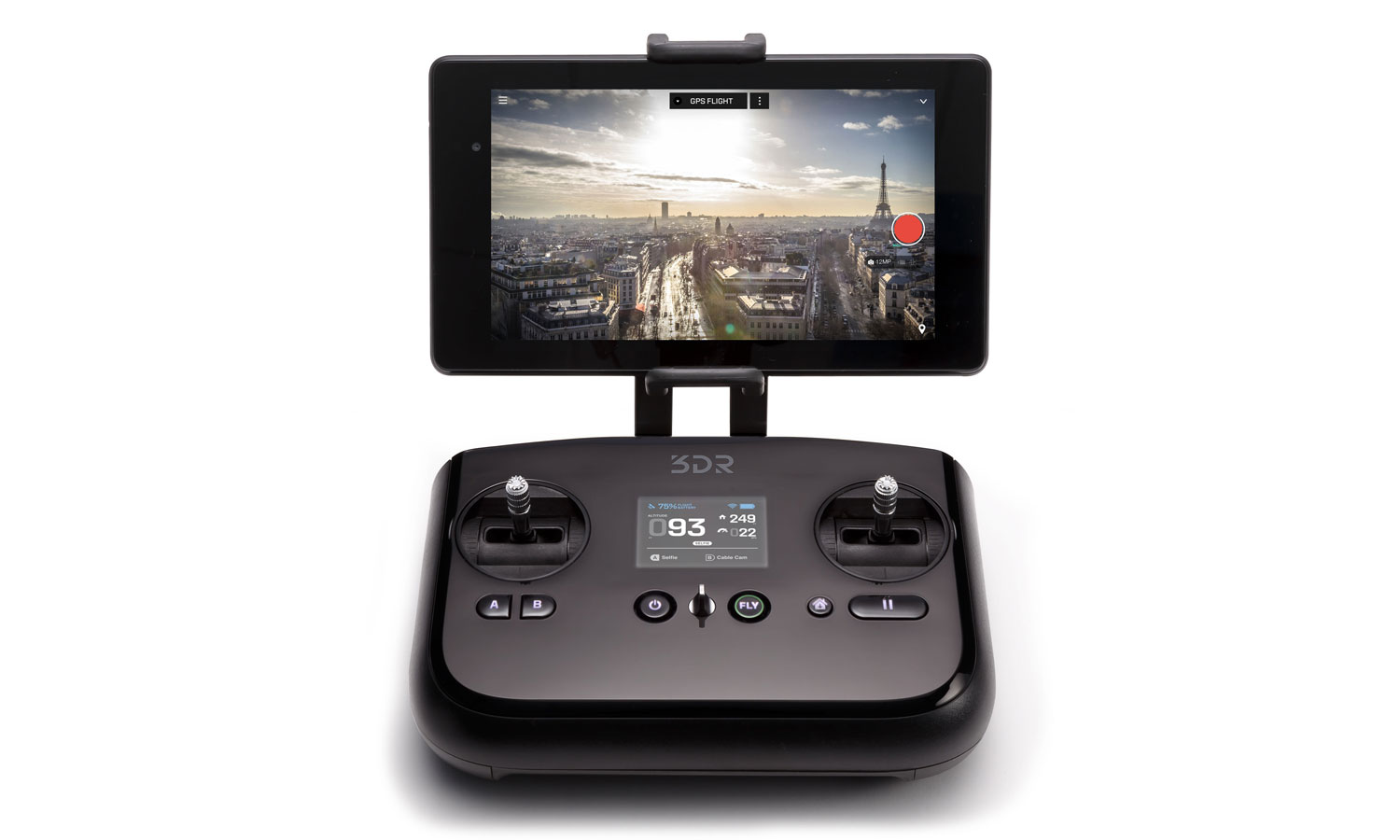
The controller fits well in my hand, with two ridges on the back providing a firm grip. The thumbs naturally fall onto the control sticks, but I could still reach over the other buttons. The index fingers on both hands can also reach the shoulder controls for the gimbal. The left control tilts the camera up and down manually, while the right shoulder control activates the automatic pan and tilt control.
The live-video preview shows up on a smartphone running the free 3DR Solo app, available for iOS and Android. This smartphone fits into a holder attached to the top of the remote control that's adjustable for different device sizes. This holds onto a smartphone tightly, but doesn't work well with anything larger than a smartphone with a 5-inch screen. I tried it with an iPad Air, and while the tablet did fit into the holder, it made the controller unbalanced: it felt like it was always about to tip forward and slip out of my hands. The Nexus 5 phone worked much better.
MORE: Best Drones - Top Rated Quadcopters on the Market
The app shows the video preview with some information and controls overlaid on it, including altitude, heading, signal strength and the controls for the camera. If you are using a GoPro Hero 4, you can also control the camera from the app, changing the shooting mode and tweaking the settings for the best image quality from the app itself. Older GoPros can still be used, but you can't control the settings on the fly.
Flying
The Solo is a simple drone to fly, with automated takeoff and landing. To take off, you let the drone sit for a minute after you turn it on (to acquire a GPS signal), then press the fly button. This starts the motors. Press the fly button again, and the Solo will take off and hover about 4 feet off the ground. The controller sticks are very responsive to subtle movements and small changes.
The Solo offers a plethora of flight modes: four video and five advanced flight. The video modes are designed for capturing specific video shots. Cable Cam creates a virtual flight path between two or multiple user-defined points, allowing the camera to pan and tilt as it flies. This makes it easy to produce flyby shots at the speed you set. Orbit mode puts the drone into a circular orbit around a chosen point, keeping the camera pointed toward the center. Follow mode sets the drone to follow the controller, remaining at a preset altitude and distance.
These modes work extremely well, and are more automated than the similar modes of the DJI Phantom 3. On the Phantom 3, the pilot controls the speed of the drone with one of the control sticks when in a flight mode, but the Solo automates that. For instance, if you set up a Cable Cam shot, but the quadcopter goes too fast, you don't have to rebuild the entire path; instead, you just change the speed slider, and the drone recalculates the path. In Orbit mode, if you decide you want the circle to be a little bit larger, just drag the radius of the path on the on-screen map and the Solo recalculates the path. The same thing applies for the speed of the orbit.
If you set up a Cable Cam shot but the quadcopter goes too fast, you don't have to rebuild the entire path. Instead you just change the speed slider, and the drone recalculates the path.
It's rather like having a co-pilot: You can focus on the video while your co-pilot keeps an eye on the details that make it happen. You do need to use some caution, of course: The drone won’t notice if it is about to fly into a tree when you widen the radius of an orbit shot (something the DJI Phantom 4 won't have to worry about, thanks to its object avoidance technology). Fortunately, there is a pause button on the controller — hit this in any flight mode and the Solo will stop and hover in place.
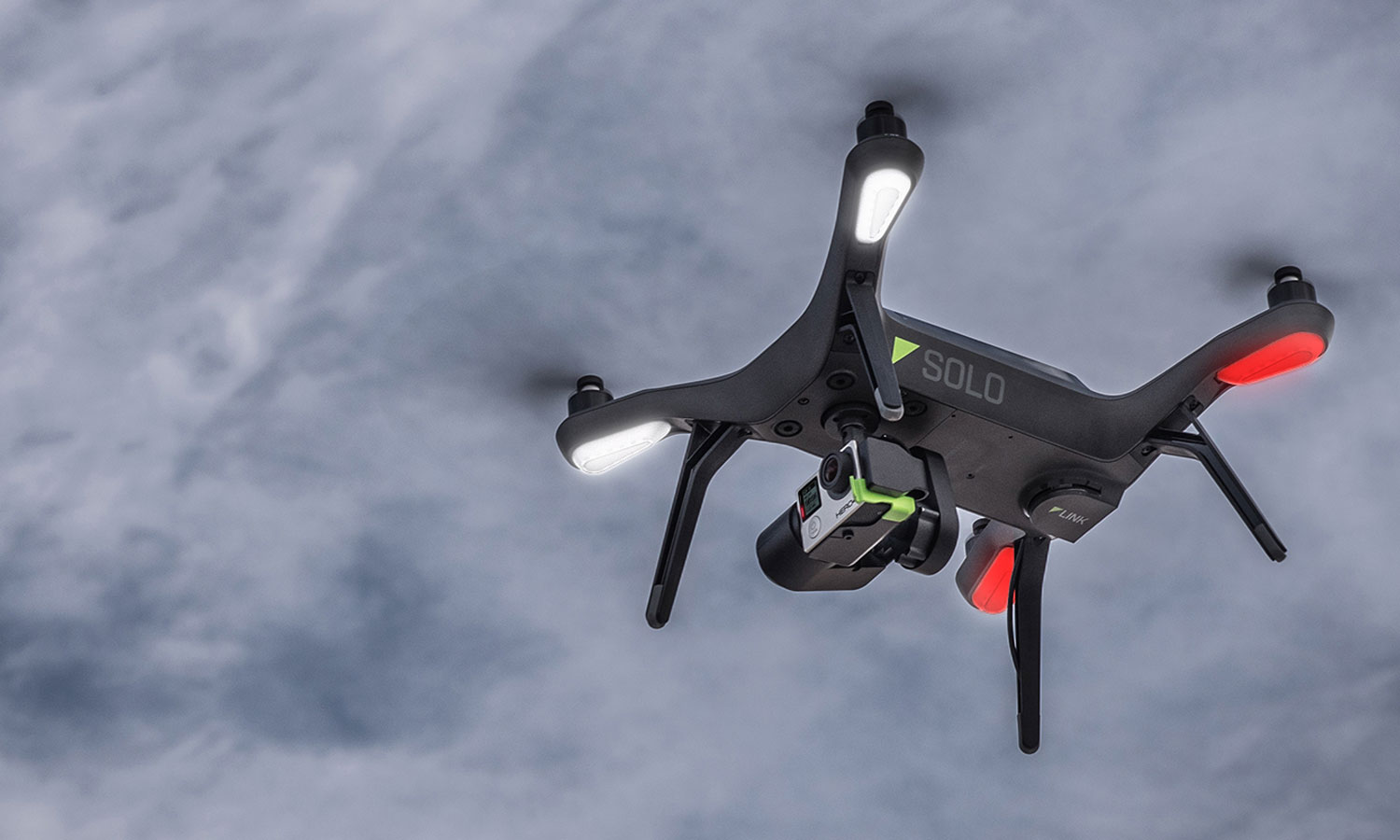
Enabling the advanced modes setting in the Solo app unlocks several new flight modes designed for acrobatic use: Fly:Manual, Stabilize, Drift, Acro and Sport. Fly:Manual turns the Solo into a fully manual quadcopter: the pilot has full control, and there is no correction for wind or the altitude. Stabilize is similar, except when you release the control sticks, the quadcopter will try to hover in place.
MORE: What the FAA's Drone Rules Mean for You
Drift interestingly makes the quadcopter fly more like an RC plane. Acro completely removes the limits on the orientation of the quadcopter, making it possible to roll and flip over. Finally, Sport mode behaves like Acro mode, but overrides the pilot if it comes too close to the ground. These modes are great fun to fly in, but do require some experience, or you may risk a costly crash.
Autonomous Flying
As you may have guessed from some of the modes, the Solo is built for autonomous flying, unlike many drones. Much of the processing power that helps it fly is built into the drone itself, rather than the controller or the phone. For instance, you can set the drone to Orbit, then put the controller down and do something else as it films and circles.
For professionals who want to use a drone for such jobs as surveying an area,this app can create 3D models or monitor construction.
The free Android (not on iOS yet) Tower app takes this a little further. In this controller app, you can select an area on a map you want to survey, and the app automatically creates a flight plan, feeds it to the drone and off it goes. For professionals who want to use a drone for such jobs as surveying an area, creating 3D models or monitoring construction, this is a very useful app. 3DR also offers a very comprehensive software development kit (SDK) called DroneKit that allows advanced users to write their own app. Although DJI offers a similar program, the 3DR one offers more access to the drone's innards itself.
Photos & Video
The Solo cannot take photos and video without an added device. Instead, it works with a GoPro camera, which connects to a control cable and an HDMI cable that feeds the video back to the drone and the controlling app. This allows the Solo to control the GoPro 4 and change settings. The older GoPro Hero 3 doesn't get the same level of control, but the drone can still stop and start video recording on the camera.
The combination worked very well, as I controlled both the drone and the GoPro from the remote, starting and stopping recording while flying as well as taking photos. The resolution and frame rate of these videos depends on the type of GoPro you use, but with a GoPro 4 Hero Black, I could shoot 4K video at 60 frames per second. GoPro 4 users also can control the resolution and frame rate of the video from the app.
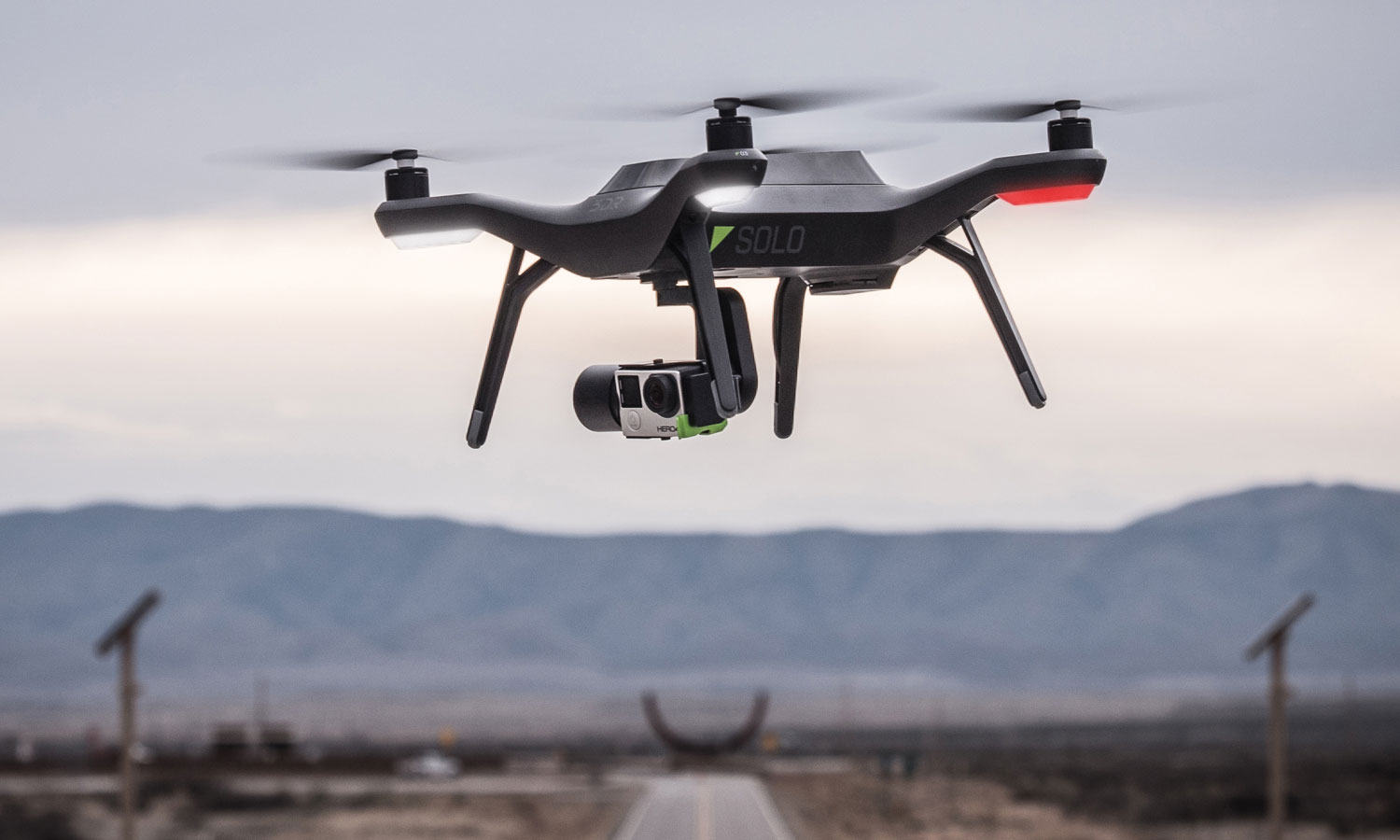
To dock the camera you can use the standard holder, or you can buy the optional gimbal. The standard holder only faces the GoPro front or down at a fixed angle. The rubber grommets it uses cushioned the GoPro from some of the buffeting and vibration of the drone in flight, but there was still some obvious vibration, which manifested as slightly fuzzy video when the drone was maneuvering.
The gimbal mount includes a number of rubber isolators that stop vibrations being transmitted to the camera, plus the motors that move the camera actively combat vibrations. This did a much better job, producing very smooth, clean video even during fairly violent maneuvers. The gimbal holds the camera steadily in place, and allows the camera to move independently, pointing left or right and up and down. The video we shot was superior to what we got with the DJI Phantom 3, as the Solo-shot footage showed none of the occasional glitches and vibrations that we saw from DJI’s drone.
The gimbal mounts helped produce a very smooth, clean video even during fairly violent maneuvers.
The remote control also offers control over the gimbal, with a manual pan/tilt on the left shoulder paddle and an automatic pan/tilt on the right shoulder. You can preprogram the buttons to change to specific camera angles with a touch. The speed at which the camera moves can be controlled by the dial between the two buttons. This combination allows you to create very smooth, professional-looking camera moves, and even reproduce an identical move on subsequent flights. That’s very useful if you are doing a time-lapse or a before-and-after shot, or if you want to have multiple takes.
The open-source nature of the Solo also means that you can attach other cameras. Using a 3D-printed adapter, I mounted a Ricoh Theta S 360-degree camera in place of the GoPro, and shot 360-degree video from 150 feet up. This adapter would work for any camera with a tripod socket as it uses a standard tripod screw.
Repairability
The Solo is a very repairable drone: 3DR sells all of the parts, from rotor blades (about $15 for two) to the frame and legs of the quadcopter (about $99 for a kit that includes replacement frame and legs, or $15 for individual legs). New motors cost about $60. These are all easy to swap out and replace: the rotors are color-coded and simply screw into place. Other components are held in place by a few screws — just undo these, and the parts pop out for replacement.
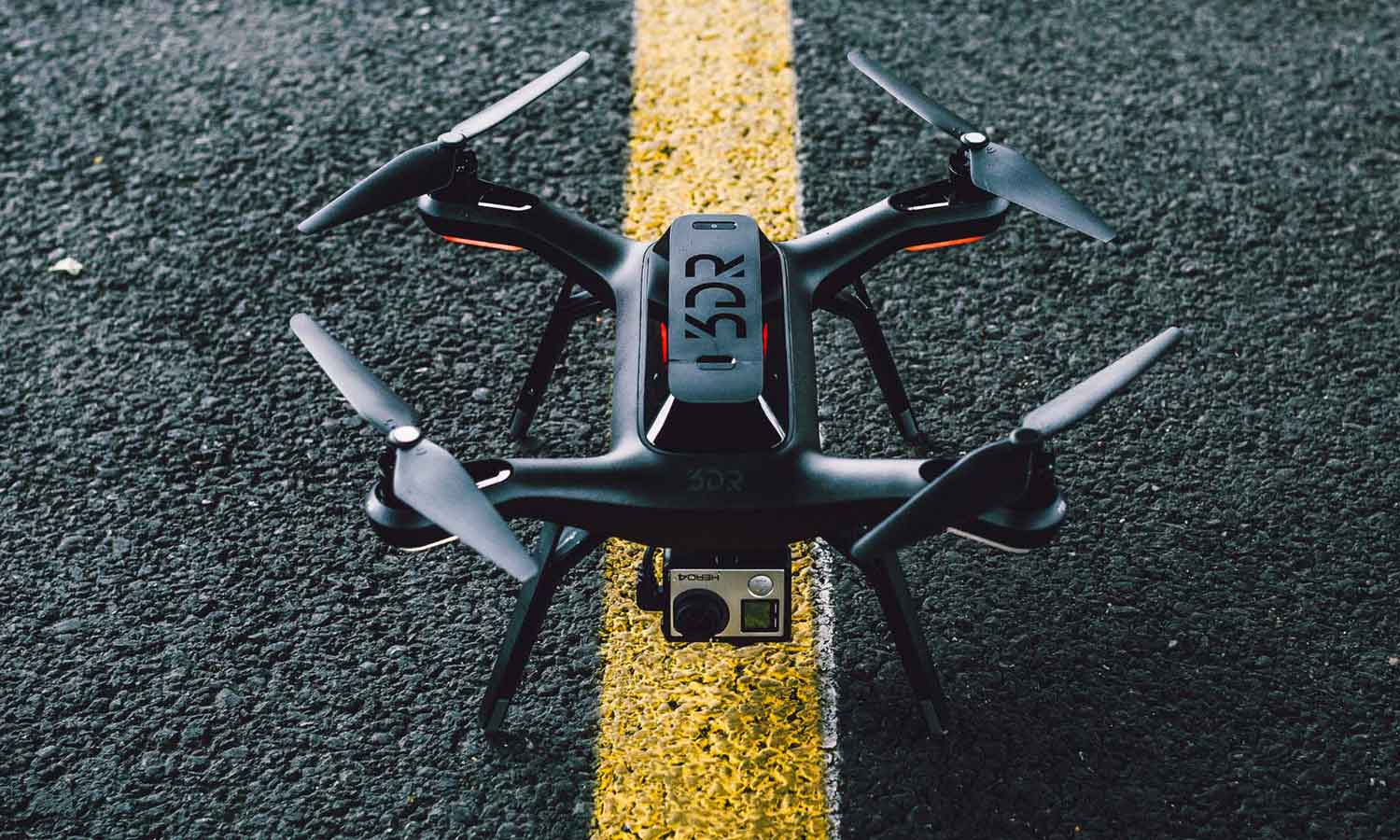
We did find that some parts of the Solo are rather fragile, though. Most crashes we had broke the rotor blades, requiring replacements. After one bad crash, the frame of the quadcopter cracked when the drone hit the ground, requiring us to replace the entire frame. This didn't cost too much (we used a crash repair kit that included a new case and new legs for $70), but it was a very complex process. To replace the frame, I had to remove all of the electronics, cabling and motors from the old case and replace them in the new one, a process that reminded me of brain surgery. Most repairs are covered in 3DR's excellent documentation, but this one wasn't.
We also had a problem with the recent 2.0 version of the 3DR Solo app. A failed update to the software on the drone and controller left the two unable to communicate, and we were unable to restore them to the previous version. 3DR sent us another drone to test and we didn't have the problem again.
Battery Life
The Solo uses a large, heavy 5,200mAh Lithium Polymer battery that latches into the top of the drone. We timed an acceptable 22 minutes of flying time in our tests, which is fairly average for this type of drone, and is comparable to the DJI Phantom 3. The DJI Phantom 4 claims it will get 28 minutes, but we'll have to wait to test that to confirm.
The Solo's battery took a long 70 minutes to recharge. You can only charge one battery at a time, and unlike the DJI Phantom 3, there are no third-party chargers available that can juice up multiple batteries. Extra batteries aren’t cheap: 3DR sells them for $149 each, and there are no third-party batteries available.
Bottom Line
The base price of the Solo bundle is now fairly cheap at $400, but you'll need to add your own GoPro to capture video, which will cost you between $100 and $400, depending on the model. That makes it about the same price as the DJI Phantom 3, which is self-contained.
But the Solo does have some advantages over its less-expensive rival. The controller and app are better than the competition, with a cleaner design and less cluttered interface. The Solo is a little easier to fly, with a more responsive remote and flight modes that are more automated and less confusing to use. It also appeals more to hackers and tinkerers, thanks to its open-source plans that allow you to get deep into the guts of the drone. If you want a drone that you can pull out of the box and start shooting with, the Phantom 3 or the Parrot Bebop 2 are better bets. But if you want to do more complex shooting and don't mind a steeper learning curve, the 3DR Solo is the drone to get.
Richard Baguley has been working as a technology writer and journalist since 1993. As well as contributing to Tom's Guide, he writes for Cnet, T3, Wired and many other publications.
-
Tony_70 Phantom 3 Standard is $499, not $799. 3DR is selling the Solo + Gimbal combo for $999 now, but there is a coupon code for subscribers of their marketing emails that lets you get the combo for $799 til the end of March.Reply -
werewe12 For that price, you better hope your drone returns back to you http://www.amazon.com/Quadcopter-Drone-Pilot-T-Shirt-Return/dp/B01BBGOQKG/ref=sr_1_3?s=apparel&ie=UTF8&qid=1457629716&sr=1-3&nodeID=7141123011Reply
